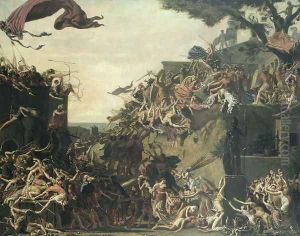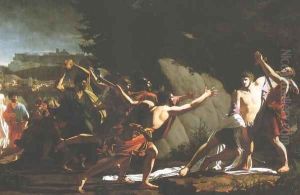Jean-Baptiste Topino-Lebrun Paintings
Jean-Baptiste Topino-Lebrun was a French painter, born in Marseille in 1764. He is often remembered not only for his artistic contributions but also for his political involvement during a tumultuous period in French history. Topino-Lebrun's early life was marked by his moving to Paris to pursue his passion for art, where he became a student of Jacques-Louis David, one of the most influential French painters of the time. Under David's mentorship, Topino-Lebrun honed his skills and was deeply influenced by the Neoclassical style, which emphasized clarity, order, and idealized beauty. This period was crucial in shaping his artistic direction, focusing on historical and mythological themes that were prevalent in the Neoclassical movement.
Throughout the 1780s and 1790s, France was engulfed by the Revolution, a period that deeply impacted Topino-Lebrun personally and professionally. His engagement with revolutionary ideals was reflected in his art as well as in his active participation in political groups. He was associated with the Jacobins, a radical political faction that played a significant role during the Revolution. This affiliation would eventually lead to his downfall. In 1801, Topino-Lebrun was implicated in a plot against Napoleon Bonaparte, who had risen to power in France. Despite his protestations of innocence, he was convicted and subsequently executed by guillotine, marking a tragic end to a life that intertwined art with political activism.
Topino-Lebrun's artistic legacy is overshadowed by his political activities and dramatic end. However, his works, which include paintings and drawings, are characterized by their emotional intensity and technical skill. They reflect the turbulent era in which he lived, marked by revolutionary fervor and the quest for a new social order. Although he did not achieve the same level of fame as his mentor, Jacques-Louis David, Topino-Lebrun's contributions to the Neoclassical movement and French art during the Revolution are noteworthy. His life and work serve as a fascinating example of the intersection between art and politics during one of the most volatile periods in French history.

